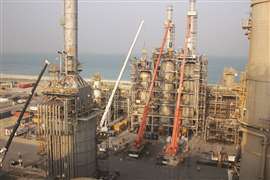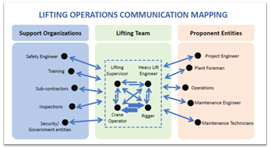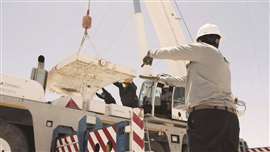How communication aids lifting operations
27 November 2023
Heavy lifting is a crucial activity for many industries all over the world.
 Effective communication is vital for project safety. (Photo: Saudi Aramco)
Effective communication is vital for project safety. (Photo: Saudi Aramco)
In the oil and gas sector, it is one of the most important milestones for new construction projects or plant equipment maintenance. In addition, most critical lifts are complicated and risky, involving many parameters to be considered. These include load weight, size, shape, rigging selection, crane capacity, weather conditions, and site layout.
Effective communication is another parameter significantly contributing to successful lifting operations and is sometimes underestimated. Primarily it concerns communication between crane operator and rigger (the lift director). Operators and riggers work together to attach, lift, and move loads. They need to communicate effectively with each other to co-ordinate the crane operations and movements, and to avoid misunderstandings that may lead to accidents.
Some best practice for communication between a lifting team include the following:
- Use clear and standard signals (verbal, hand, or radio) to indicate the actions and movements required
- Assign only one person to signal the crane operator
- Confirm the understanding of the signals and instructions before executing them
- Maintain eye contact or line of sight whenever possible
- Immediately report any problems or changes in the lifting operation
- Identify critical risk and agree on the way to handle it
- Determine any potential sources of danger, for example, chemical, electrical, traffic, or communications, and establish procedures to deal with it
- Stop the lift if there is any doubt or confusion.
International standards and industry best practice give considerable focus to such communications. Many standards suggest using Simi-universal sign language to ensure directions are clearly communicated. As an example, ASME B30.5 in the USA allocates section 5-3.3 for signals where specific communication methods are recommended for unique lifting operations. ASME also specifies guidelines for visual and audio signals and describes certain conditions to ensure safe lifting operations. ASME states, “Communication between the crane operator and the signalperson shall be maintained continuously during all crane movement.” The standard also requires stopping the crane whenever there is confusion or it is desired to give different directions other than what was communicated by the signalperson. This signifies the critical role that communication plays in safe and successful crane lifts.
Critical lifts
The importance of effective communication becomes greater in critical and very specialized lifts. During such activities, a higher level of planning, supervision, and communication is required than during ‘normal’ lifts. Critical lifts should be identified and well-planned with step-by-step procedures that take into consideration all lifting parameters.
 Diagram illustrating the communication mapping for lifting operations. (Photo: Saudi Aramco)
Diagram illustrating the communication mapping for lifting operations. (Photo: Saudi Aramco)
A detailed and comprehensive lift plan should also be developed, reviewed and approved, by all involved parties, including the client, contractor, heavy lift engineer, supervisor, rigger, crane operator, and safety advisor. Such activity requires a high level of communication with all involved personnel who have a role in the critical lift.
When executing a critical lift, the communication methodology should be agreed upon with clear guidelines between the lifting team. All signals, instructions, and audio commands should be clear, consistent, confirmed and tested prior to the lift. Any deviations from the approved lift plan should be reported and resolved immediately among lifting team.
Communication network
In addition to riggers and crane operators, the other professionals involved in planning, supervising, and executing lifts must be considered. These include project engineers, facility proponents, maintenance staff and safety advisors. Effective communication among all stakeholders is essential to ensure the lifting operation is well-planned, appropriately supervised, and carried out safely.
The role of each person dictates establishing accurate communication towards successful completion of the lift. For example, project and maintenance engineers who requested the lift need to clarify various key data to the lifting team, which may include total weight, centre of gravity, sharing certain drawings or confirming load stability, special lift consideration and structural integrity.
 Follow best practice for lifting team communication. (Photo: Saudi Aramco)
Follow best practice for lifting team communication. (Photo: Saudi Aramco)
In addition, facility proponents need to ensure the lifting area is safe and ready to accommodate the lifting equipment. This may involve shutting down certain plant process equipment or checking for any underground utilities that might affect the position of the cranes.
The simplified diagram illustrates the communication mapping for lifting operations. It shows a heavy flow of information between the lifting team with its peak between the crane operator and rigger(s). This makes sense as the actual lifting activities will be handled mainly by these two people. Similarly, the lifting supervisor and heavy lift engineer are responsible for communicating various lifting information both to the crane operators and to the riggers, helping ensure safe and successful lifting activities.
Other involved organisations are also shown which visualise the lifting communication complexity. Some of these communications should be established during the lift planning stage, others may be needed just before or during the actual lift. It is important that the lifting team communicate any missing information or doubtful items ahead of time as this might affect the lift.
Such communication is known as centralised communication or networking where a person or group is at the centre of the whole communication (Danny Samson & Timothy Donnet, Management, 2020, 7th edition). This communication type is known to be practical to control and manage many involved parties who contribute to complex tasks.
Effective communication is a vital element for ensuring the safety and efficiency of heavy-lifting operations. It enables co-ordination, co-operation, and control among the various parties involved in planning, supervising, and carrying out lifting operations. It helps prevent accidents, errors and delays that can compromise the quality and productivity of lifting operations. It is imperative that all personnel involved in heavy lifting operations develop and maintain their communication skills to the highest standards to ensure the success of such operations.
ABOUT THE AUTHOR

Mustafa Al Abdulmohsin is a heavy lift engineer who has been working at Saudi Aramco for more than 10 years. His experience focuses on managing different equipment services, primarily mobile cranes, which provide lifts for Saudi Aramco oil and gas plants in Saudi Arabia.
STAY CONNECTED


Receive the information you need when you need it through our world-leading magazines, newsletters and daily briefings.
CONNECT WITH THE TEAM







